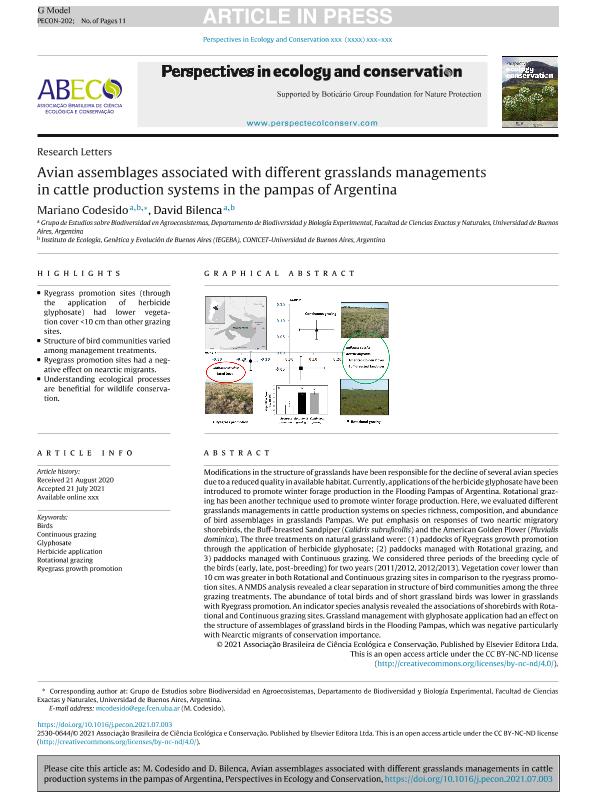Mostrar el registro sencillo del ítem
dc.contributor.author
Codesido, Mariano

dc.contributor.author
Bilenca, David Norberto

dc.date.available
2022-12-15T12:44:07Z
dc.date.issued
2021-08
dc.identifier.citation
Codesido, Mariano; Bilenca, David Norberto; Avian assemblages associated with different grasslands managements in cattle production systems in the pampas of Argentina; Elsevier; Perspectives in Ecology and Conservation; 19; 4; 8-2021; 464-474
dc.identifier.issn
2530-0644
dc.identifier.uri
http://hdl.handle.net/11336/181269
dc.description.abstract
Modifications in the structure of grasslands have been responsible for the decline of several avian species due to a reduced quality in available habitat. Currently, applications of the herbicide glyphosate have been introduced to promote winter forage production in the Flooding Pampas of Argentina. Rotational grazing has been another technique used to promote winter forage production. Here, we evaluated different grasslands managements in cattle production systems on species richness, composition, and abundance of bird assemblages in grasslands Pampas. We put emphasis on responses of two neartic migratory shorebirds, the Buff-breasted Sandpiper (Calidris subruficollis) and the American Golden Plover (Pluvialis dominica). The three treatments on natural grassland were: (1) paddocks of Ryegrass growth promotion through the application of herbicide glyphosate; (2) paddocks managed with Rotational grazing, and 3) paddocks managed with Continuous grazing. We considered three periods of the breeding cycle of the birds (early, late, post-breeding) for two years (2011/2012, 2012/2013). Vegetation cover lower than 10 cm was greater in both Rotational and Continuous grazing sites in comparison to the ryegrass promotion sites. A NMDS analysis revealed a clear separation in structure of bird communities among the three grazing treatments. The abundance of total birds and of short grassland birds was lower in grasslands with Ryegrass promotion. An indicator species analysis revealed the associations of shorebirds with Rotational and Continuous grazing sites. Grassland management with glyphosate application had an effect on the structure of assemblages of grassland birds in the Flooding Pampas, which was negative particularly with Nearctic migrants of conservation importance.
dc.format
application/pdf
dc.language.iso
eng
dc.publisher
Elsevier

dc.rights
info:eu-repo/semantics/openAccess
dc.rights.uri
https://creativecommons.org/licenses/by-nc-nd/2.5/ar/
dc.subject
BIRDS
dc.subject
CONTINUOUS GRAZING
dc.subject
GLYPHOSATE
dc.subject
HERBICIDE APPLICATION
dc.subject
ROTATIONAL GRAZING
dc.subject
RYEGRASS GROWTH PROMOTION
dc.subject.classification
Ecología

dc.subject.classification
Ciencias Biológicas

dc.subject.classification
CIENCIAS NATURALES Y EXACTAS

dc.title
Avian assemblages associated with different grasslands managements in cattle production systems in the pampas of Argentina
dc.type
info:eu-repo/semantics/article
dc.type
info:ar-repo/semantics/artículo
dc.type
info:eu-repo/semantics/publishedVersion
dc.date.updated
2022-09-28T16:29:44Z
dc.journal.volume
19
dc.journal.number
4
dc.journal.pagination
464-474
dc.journal.pais
Brasil

dc.description.fil
Fil: Codesido, Mariano. Consejo Nacional de Investigaciones Científicas y Técnicas. Oficina de Coordinación Administrativa Ciudad Universitaria. Instituto de Ecología, Genética y Evolución de Buenos Aires. Universidad de Buenos Aires. Facultad de Ciencias Exactas y Naturales. Instituto de Ecología, Genética y Evolución de Buenos Aires; Argentina
dc.description.fil
Fil: Bilenca, David Norberto. Consejo Nacional de Investigaciones Científicas y Técnicas. Oficina de Coordinación Administrativa Ciudad Universitaria. Instituto de Ecología, Genética y Evolución de Buenos Aires. Universidad de Buenos Aires. Facultad de Ciencias Exactas y Naturales. Instituto de Ecología, Genética y Evolución de Buenos Aires; Argentina
dc.journal.title
Perspectives in Ecology and Conservation
dc.relation.alternativeid
info:eu-repo/semantics/altIdentifier/url/https://linkinghub.elsevier.com/retrieve/pii/S2530064421000705
dc.relation.alternativeid
info:eu-repo/semantics/altIdentifier/doi/http://dx.doi.org/10.1016/j.pecon.2021.07.003
Archivos asociados
